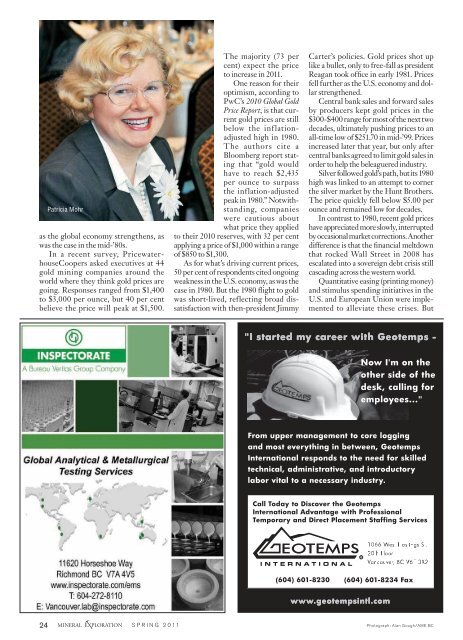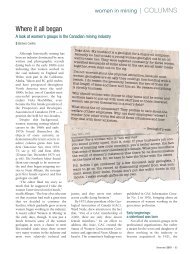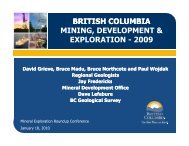Spring 2011 - The Association for Mineral Exploration British Columbia
Spring 2011 - The Association for Mineral Exploration British Columbia
Spring 2011 - The Association for Mineral Exploration British Columbia
You also want an ePaper? Increase the reach of your titles
YUMPU automatically turns print PDFs into web optimized ePapers that Google loves.
Patricia Mohr<br />
as the global economy strengthens, as<br />
was the case in the mid-’80s.<br />
In a recent survey, PricewaterhouseCoopers<br />
asked executives at 44<br />
gold mining companies around the<br />
world where they think gold prices are<br />
going. Responses ranged from $1,400<br />
to $3,000 per ounce, but 40 per cent<br />
believe the price will peak at $1,500.<br />
<strong>The</strong> majority (73 per<br />
cent) expect the price<br />
to increase in <strong>2011</strong>.<br />
One reason <strong>for</strong> their<br />
optimism, according to<br />
PwC’s 2010 Global Gold<br />
Price Report, is that current<br />
gold prices are still<br />
below the inflationadjusted<br />
high in 1980.<br />
<strong>The</strong> authors cite a<br />
Bloomberg report stating<br />
that “gold would<br />
have to reach $2,435<br />
per ounce to surpass<br />
the inflation-adjusted<br />
peak in 1980.” Notwithstanding,<br />
companies<br />
were cautious about<br />
what price they applied<br />
to their 2010 reserves, with 32 per cent<br />
applying a price of $1,000 within a range<br />
of $850 to $1,300.<br />
As <strong>for</strong> what’s driving current prices,<br />
50 per cent of respondents cited ongoing<br />
weakness in the U.S. economy, as was the<br />
case in 1980. But the 1980 flight to gold<br />
was short-lived, reflecting broad dissatisfaction<br />
with then-president Jimmy<br />
Carter’s policies. Gold prices shot up<br />
like a bullet, only to free-fall as president<br />
Reagan took office in early 1981. Prices<br />
fell further as the U.S. economy and dollar<br />
strengthened.<br />
Central bank sales and <strong>for</strong>ward sales<br />
by producers kept gold prices in the<br />
$300-$400 range <strong>for</strong> most of the next two<br />
decades, ultimately pushing prices to an<br />
all-time low of $251.70 in mid-’99. Prices<br />
increased later that year, but only after<br />
central banks agreed to limit gold sales in<br />
order to help the beleaguered industry.<br />
Silver followed gold’s path, but its 1980<br />
high was linked to an attempt to corner<br />
the silver market by the Hunt Brothers.<br />
<strong>The</strong> price quickly fell below $5.00 per<br />
ounce and remained low <strong>for</strong> decades.<br />
In contrast to 1980, recent gold prices<br />
have appreciated more slowly, interrupted<br />
by occasional market corrections. Another<br />
difference is that the financial meltdown<br />
that rocked Wall Street in 2008 has<br />
escalated into a sovereign debt crisis still<br />
cascading across the western world.<br />
Quantitative easing (printing money)<br />
and stimulus spending initiatives in the<br />
U.S. and European Union were implemented<br />
to alleviate these crises. But<br />
24 SPRING <strong>2011</strong> Photograph: Alan Gough/AME BC





